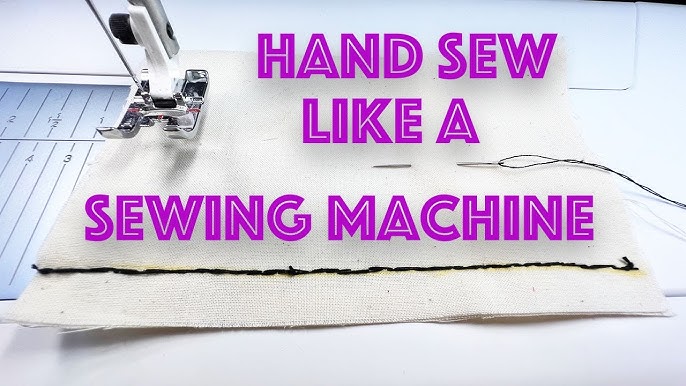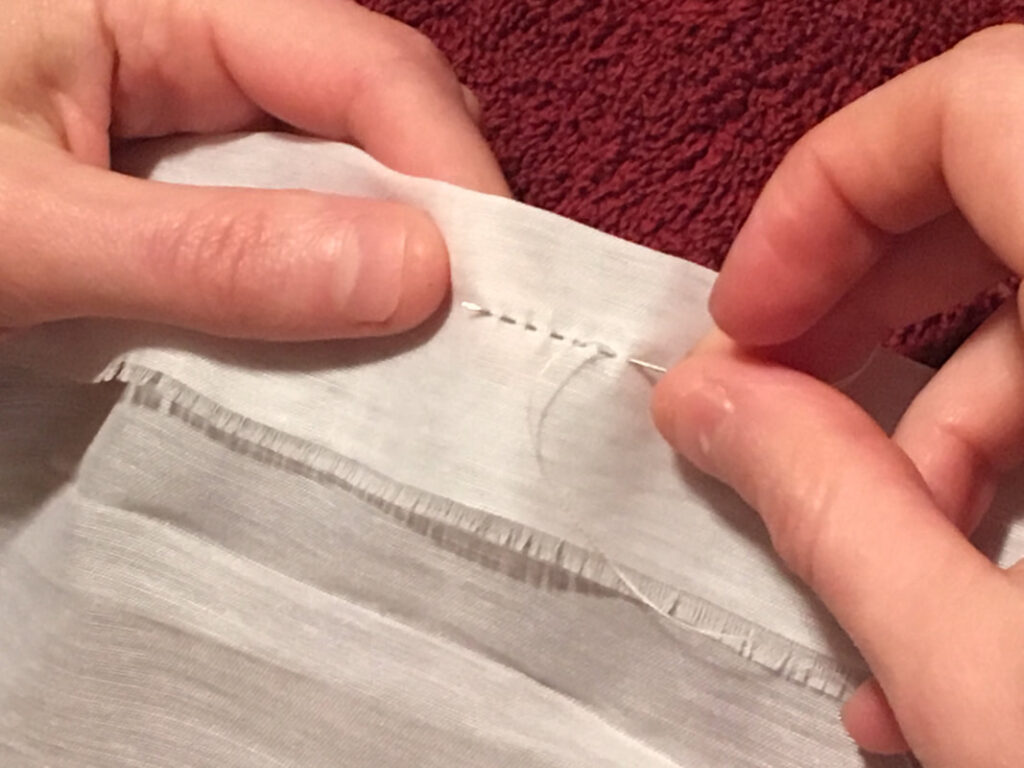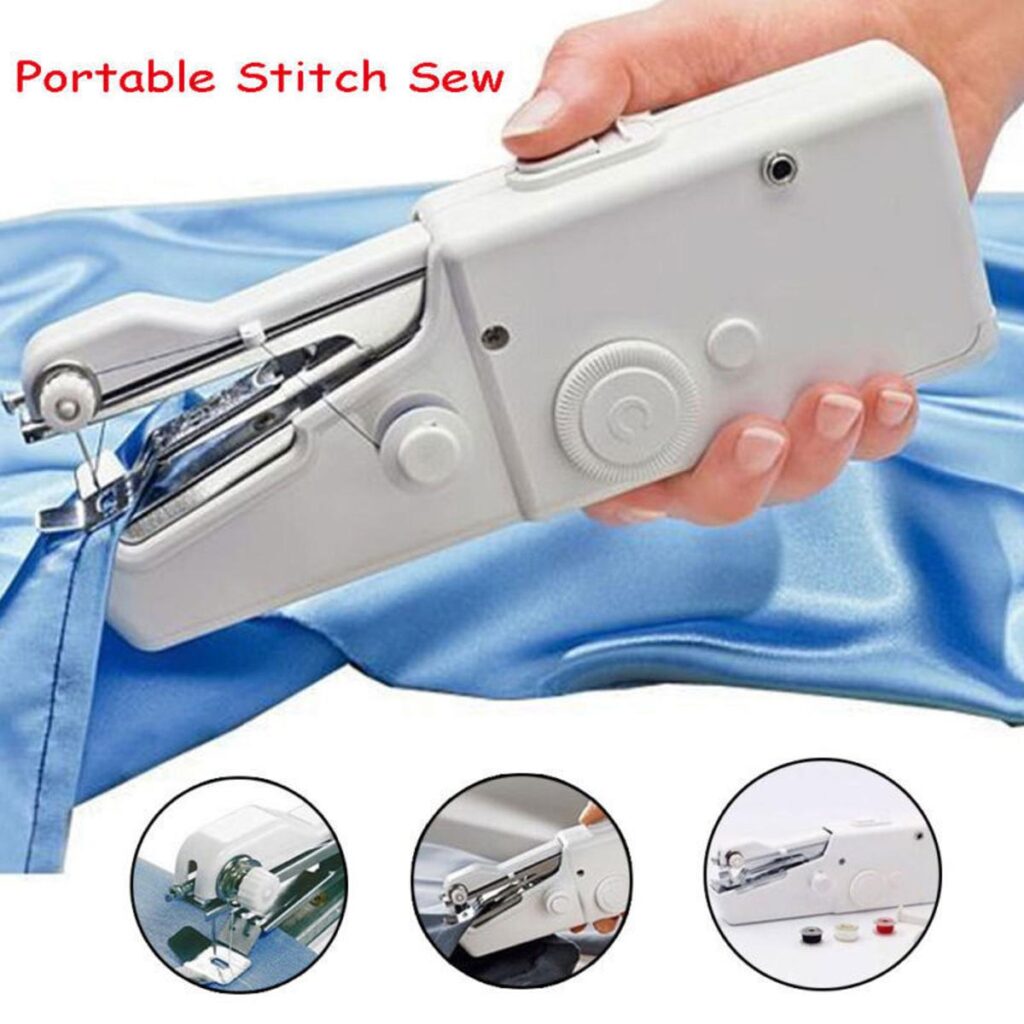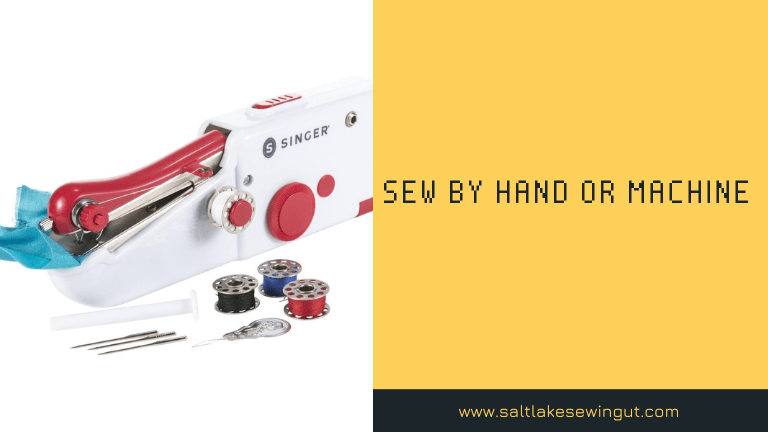We’ll explore the pros and cons of both Sew By Hand or Machine helping you make an informed decision on which approach suits you best. The age-old debate between sewing by hand and using a machine continues to spark curiosity among enthusiasts and beginners alike. While both methods sewing by Hand or Machine have their advantages and disadvantages, the choice ultimately depends on your specific needs, preferences, and the project at hand.
History teaches us that hand sewing can rival machine sewing in terms of durability. Garments from centuries ago have been discovered in remarkable condition, attesting to the strength of hand-crafted stitches. Looking back in time, we find that the sewing machine is a relatively recent invention, emerging in the 19th century. Even after its creation, it took some time before it became a common household tool.
Everyday clothing continued to be painstakingly handcrafted, either at home or by skilled local seamstresses. While it’s true that some of these traditional sewing skills have faded with time, there remains a dedicated community of sewers in countries like the U.S. who possess the ability to create nearly invisible, robust seams.

Sew By Hand or Machine: Which is Better?
Hand Sewing
Advantages:
For newcomers to the world of sewing, hand sewing offers an economical entry point. To embark on simple projects, all you really need are basic tools like a needle, thread, scissors, and a thimble. Furthermore, hand sewing doesn’t demand any electricity aside from a small lamp to illuminate your work area. Another notable advantage is its portability. Compact hand-sewn projects can accompany you anywhere, providing a soothing distraction during plane rides or while waiting in a doctor’s office.
In terms of space, hand sewing is the more modest option. If your living quarters are tight in the room, hand sewing can usually be confined to a small basket or sewing box. In contrast, a sewing machine, along with its assorted accessories, necessitates dedicated space. Even if the machine is stashed away between uses, it still occupies space during extended projects.
The precision achievable through hand sewing is invaluable. As a professional seamstress, I’ve encountered situations where I’ve had to partially machine stitch certain seams and then complete them by hand to achieve the desired aesthetic or ensure the garment drapes correctly. Some projects demand meticulous control over each individual stitch.
Hand sewing may be gentler on delicate or lightweight fabrics. While sewing machines can handle most materials, there’s a greater risk of snagging or pulling delicate fabrics when using a machine as opposed to sewing by hand. Certain historical costumes, in the pursuit of authenticity, are traditionally sewn by hand. Leatherwork, both in domestic settings and small leather goods businesses, often relies on hand-sewn running stitches, which provide greater strength compared to machine-locking stitches.
Beyond its practical advantages, hand sewing can also have therapeutic benefits. Establishing a tranquil, unhurried rhythm during any crafting endeavor can promote overall mental and emotional well-being. Research has shown that engaging in handcrafts such as crocheting, knitting, hand sewing, or embroidery can offer both physical and mental rewards.
Precision: Hand sewing allows for precise control over each stitch, making it ideal for intricate and detailed work. This precision is particularly important when working on delicate fabrics or intricate designs.
Portability: Hand sewing can be done almost anywhere, making it a highly portable skill. You can sew on the go, in various settings, or even when you don’t have access to electricity or a sewing machine.
Cost-effective: Hand sewing doesn’t require the upfront investment in a sewing machine and its associated maintenance costs. It’s an accessible and budget-friendly way to mend, alter, or create clothing and textiles.
Versatility: Hand-sewing techniques can be used for a wide range of tasks, from basic repairs and alterations to crafting intricate embroidery and embellishments. This versatility makes it suitable for various projects.
Connection to Tradition: Hand sewing connects people to a rich historical tradition of craftsmanship. Many traditional and cultural textiles are still created using hand-sewing techniques, preserving cultural heritage.
Sustainability: Hand sewing promotes sustainability by encouraging the repair and reuse of clothing and textiles, reducing the need for new purchases, and minimizing waste.
Skill Development: Learning to hand sew can be a fulfilling skill-building experience. It offers the opportunity to develop patience, dexterity, and problem-solving abilities.
Personalization: Hand sewing allows for a personal touch in your creations. You can choose unique stitches, threads, and embellishments to customize your projects and make them truly one-of-a-kind.
Relaxation: For many, hand sewing is a calming and meditative activity. It provides a break from the fast pace of modern life and offers a chance to unwind and de-stress.
Accessibility: Hand sewing is accessible to people of all ages and skill levels, making it a valuable skill for both beginners and experienced sewers alike.

Disadvantages:
Even the most seasoned sewers anticipate a degree of irregularity when engaging in hand sewing. Achieving perfectly uniform stitches is a nearly impossible feat for the human hand. Some may argue that this imperfection adds to the allure of hand sewing. Hand sewing demands significantly more time than machine sewing. It calls for a greater degree of patience and isn’t well-suited for projects with tight deadlines.
Time-Consuming: Hand sewing is generally more time-consuming than using a sewing machine. Each stitch must be made individually, which can be labor-intensive, especially for larger or complex projects.
Limited Speed: Hand sewing is slower compared to machine sewing. This can be a drawback when you have a tight deadline or need to complete a project quickly.
Limited Stitch Consistency: Achieving consistent stitch lengths and tension can be challenging with hand sewing, especially for beginners. In contrast, sewing machines can produce uniform stitches effortlessly.
Physical Strain: Prolonged hand sewing can lead to hand and wrist fatigue, especially if you’re working on a large project. Sewing machines are designed to reduce physical strain.
Difficulty with Heavy Fabrics: Hand sewing heavy or thick fabrics, such as denim or leather, can be physically demanding and may require specialized needles and techniques. Sewing machines are better suited for heavy-duty tasks.
Limited Stitch Variety: Hand sewing is versatile, but it may not offer the same range of decorative stitches and techniques as sewing machines, which have various built-in options.
Inconsistent Tension: Maintaining consistent thread tension can be challenging when hand sewing, leading to uneven stitches and potential issues with the finished product’s appearance.
Not Ideal for Mass Production: Hand sewing is not practical for large-scale or mass production of garments or textiles. Sewing machines are more efficient for high-volume manufacturing.
Skill Requirement: Hand sewing requires a certain level of skill and practice to achieve professional-looking results. Beginners may find it challenging to produce neat, durable stitches.
Limited Durability for Some Applications: While hand sewing can be highly durable, it may not always provide the same level of strength and longevity as machine stitching, particularly for heavy-duty items like industrial workwear or heavy canvas products.
Limited Consistency for Repetitive Tasks: Repetitive tasks, such as sewing long straight seams or making multiple identical stitches, can be tedious and may result in variations in the finished product.
Hand sewing offers numerous benefits but may not be the best choice for all sewing projects, particularly those that require speed, precision, or consistency. The choice between hand sewing and machine sewing depends on the specific requirements of the task and the preferences and skills of the sewist.
Machine Sewing
Advantages:
Machine sewing offers numerous advantages, making it a popular choice for a wide range of sewing projects:
Speed: Sewing machines are significantly faster than hand sewing. They can stitch quickly and consistently, making them ideal for completing projects efficiently.
Precision: Sewing machines can produce uniform and precise stitches, ensuring a professional and polished appearance for garments and textiles.
Consistency: Machines maintain consistent stitch length and tension throughout a project, reducing the likelihood of errors or irregularities in the final product.
Versatility: Modern sewing machines come with various stitch options, allowing sewers to create decorative stitches, buttonholes, zigzags, and more. This versatility expands the range of projects that can be undertaken.
Efficiency: Sewing machines can handle repetitive tasks with ease, such as sewing long straight seams or producing multiple identical stitches, which can be tedious and time-consuming when done by hand.
Durability: Machine-sewn seams are often more durable than hand-sewn ones, making them suitable for heavy-duty projects like upholstery or outdoor gear.
Time Savings: For those with busy schedules, sewing machines can significantly reduce the time required to complete sewing tasks, making it easier to balance sewing with other commitments.
Professional Finish: Sewing machines can achieve a polished and finished look, which is especially important for creating high-quality clothing and home decor items.
Accessibility: While sewing machines do require an initial investment, they are accessible to a wide range of skill levels, from beginners to experienced sewers. Many affordable options are available.
Conserve Energy: Sewing machines require less physical effort than hand sewing, reducing the risk of hand and wrist strain during long sewing sessions.
Scalability: Sewing machines are well-suited for both Sew By Hand or Machine small-scale and large-scale production, making them essential tools for those who sew for personal use or run sewing businesses.
Decorative Options: Some sewing machines offer features like embroidery and monogramming, enabling users to add intricate designs and personalization to their projects.
Quilting and Patchwork: Sewing machines equipped with quilting features can simplify the process of creating quilts and patchwork projects, making them more accessible to enthusiasts.
Sewing machines provide speed, precision, and versatility, making them indispensable tools for a wide range of sewing endeavors, from clothing construction to crafting and home decor. Their efficiency and consistent results make them particularly beneficial for both hobbyists and professionals.

Disadvantages:
Cost: Sewing machines can be expensive, particularly high-quality and feature-rich models. This initial investment can be a barrier for some individuals, especially beginners.
Learning Curve: Operating a sewing machine effectively requires learning how to thread it, select appropriate stitches, and adjust tension settings. Beginners may find this learning curve intimidating.
Maintenance: Sewing machines require regular maintenance, such as cleaning, oiling, and occasional repairs. Neglecting maintenance can lead to decreased machine performance or even costly breakdowns.
Limited Portability: Sewing machines are not as portable as hand sewing. They are typically bulkier and require a stable surface to operate effectively. This limits their use in certain settings or for on-the-go projects.
Noise: Sewing machines can be noisy, which may be a concern for those who prefer a quieter sewing environment.
Complexity for Complex Projects: While sewing machines excel at many tasks, they may struggle with extremely complex or delicate projects that require intricate handwork. In such cases, hand sewing may still be necessary.
Lack of Control: Sewing machines provide speed and precision, but they can also be less forgiving than hand sewing when it comes to making corrections or adjustments on the fly.
Limited Stitch Creativity: Although modern sewing machines offer various stitch options, they may not provide the same level of creative freedom as hand sewing for unique or artistic projects.
Maintenance Costs: In addition to the initial cost of the sewing machine, there are ongoing expenses for items like replacement needles, bobbins, and specialized presser feet.
Dependence on Electricity: Sewing machines rely on electricity, which means they may not be usable during power outages or in areas with unreliable electricity sources.
Space Requirements: Sewing machines, even when not in use, take up space in your home. This can be a concern if you have limited storage or workspace.
Repairs and Servicing: When sewing machines require repairs or servicing, it can be inconvenient and costly. Depending on the availability of service centers, you may experience downtime in your sewing projects.
Limited Sewing Materials: Some sewing machines may not work well with extremely thick or delicate fabrics, limiting the range of materials you can work with effectively.
While sewing machines offer numerous advantages, they also come with certain drawbacks, including cost, maintenance requirements, and limitations on portability and creative freedom. The choice between Sew By Hand or Machine depends on the specific needs of the project and the preferences of the sewist.
Sew By Hand or Machine: The Best Choice for Your Sewing Projects
Certain projects are optimized by hand sewing, while others are better suited for machine sewing to achieve the best possible outcome.
Minor repairs
Minor repairs can often be quickly and easily addressed with the right tools and techniques.
Quilting
Quilting is a traditional craft that involves stitching together layers of fabric to create a padded, decorative textile.
Entire Garments
Creating entire garments involves sewing together various fabric pieces to construct clothing items, such as dresses, shirts, pants, or jackets.
Creative Embellishments
Creative embellishments refer to the decorative elements and enhancements added to fabric or textile projects to enhance their visual appeal. These embellishments can include embroidery, beading, appliqué, and various other artistic techniques.
Final Thought
The choice between sewing by Hand or Machine as well as the specific techniques and embellishments used, ultimately depends on your project’s nature, skill level, and personal preferences. Both methods have their strengths and can be valuable tools in your sewing repertoire, allowing you to bring your creative visions to life.
Making Your Choice
Consider Your Project
The choice between sewing by Hand or Machine largely depends on your project:
For intricate, detailed work, such as embroidery or heirloom projects, hand sewing provides the precision you need.
For everyday clothing, home decor, or quilting, machine sewing offers efficiency and durability.
Personal Preference
Your personal preference plays a significant role. Some people find solace in the slow, deliberate nature of hand sewing, while others appreciate the speed and convenience of a sewing machine.
Skill Level
Consider your skill level. Beginners might find hand sewing more accessible, while experienced sewists can leverage the power of sewing machines.
Can I use a sewing machine for delicate fabrics?
Yes, sewing machines can be used for delicate fabrics, but it’s essential to adjust the settings and use the appropriate needle and thread to prevent damage.
Is hand sewing suitable for repairing torn clothing?
Hand sewing is excellent for repairing small tears or loose hems in clothing, offering a discreet and durable solution.
What type of projects are best suited for machine sewing?
Machine sewing is ideal for projects that require strength and durability, such as making curtains, sewing denim, or constructing bags and accessories.
Are there hybrid techniques that combine both sewing by Hand or Machine?
Yes, some projects benefit from a combination of sewing by Hand or Machine For example, you can hand-sew intricate details on a machine-sewn garment.
How can I improve my Sew By Hand or Machine skills?
Improving your sewing skills takes practice. Consider taking classes, watching tutorials, and experimenting with different techniques to become a more proficient sewist.


1 thought on “Is It Better To Sew By Hand or Machine?”